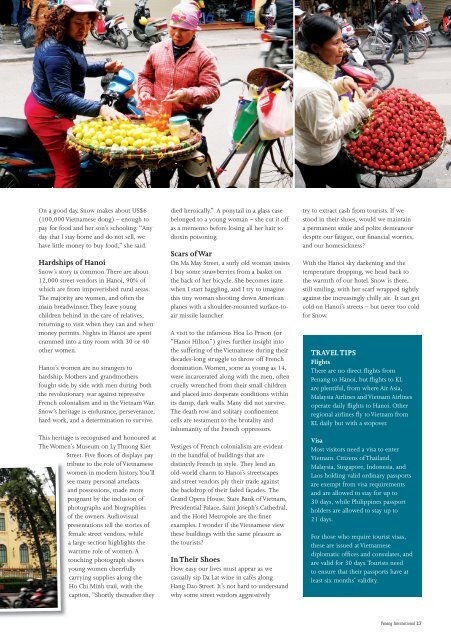Celebrate Heritage! Hidden Retreat The Road ... - The Expat Group
Celebrate Heritage! Hidden Retreat The Road ... - The Expat Group
Celebrate Heritage! Hidden Retreat The Road ... - The Expat Group
Create successful ePaper yourself
Turn your PDF publications into a flip-book with our unique Google optimized e-Paper software.
On a good day, Snow makes about US$6<br />
(100,000 Vietnamese dong) – enough to<br />
pay for food and her son’s schooling. “Any<br />
day that I stay home and do not sell, we<br />
have little money to buy food,” she said.<br />
Hardships of Hanoi<br />
Snow’s story is common. <strong>The</strong>re are about<br />
12,000 street vendors in Hanoi, 90% of<br />
which are from impoverished rural areas.<br />
<strong>The</strong> majority are women, and often the<br />
main breadwinner. <strong>The</strong>y leave young<br />
children behind in the care of relatives,<br />
returning to visit when they can and when<br />
money permits. Nights in Hanoi are spent<br />
crammed into a tiny room with 30 or 40<br />
other women.<br />
Hanoi’s women are no strangers to<br />
hardship. Mothers and grandmothers<br />
fought side by side with men during both<br />
the revolutionary war against repressive<br />
French colonialism and in the Vietnam War.<br />
Snow’s heritage is endurance, perseverance,<br />
hard work, and a determination to survive.<br />
This heritage is recognised and honoured at<br />
<strong>The</strong> Women’s Museum on Ly Thuong Kiet<br />
Street. Five floors of displays pay<br />
tribute to the role of Vietnamese<br />
women in modern history. You’ll<br />
see many personal artefacts<br />
and possessions, made more<br />
poignant by the inclusion of<br />
photographs and biographies<br />
of the owners. Audiovisual<br />
presentations tell the stories of<br />
female street vendors, while<br />
a large section highlights the<br />
wartime role of women. A<br />
touching photograph shows<br />
young women cheerfully<br />
carrying supplies along the<br />
Ho Chi Minh trail, with the<br />
caption, “Shortly thereafter they<br />
died heroically.” A ponytail in a glass case<br />
belonged to a young woman – she cut it off<br />
as a memento before losing all her hair to<br />
dioxin poisoning.<br />
Scars of War<br />
On Ma May Street, a surly old woman insists<br />
I buy some strawberries from a basket on<br />
the back of her bicycle. She becomes irate<br />
when I start haggling, and I try to imagine<br />
this tiny woman shooting down American<br />
planes with a shoulder-mounted surface-toair<br />
missile launcher.<br />
A visit to the infamous Hoa Lo Prison (or<br />
“Hanoi Hilton”) gives further insight into<br />
the suffering of the Vietnamese during their<br />
decades-long struggle to throw off French<br />
domination. Women, some as young as 14,<br />
were incarcerated along with the men, often<br />
cruelly wrenched from their small children<br />
and placed into desperate conditions within<br />
its damp, dark walls. Many did not survive.<br />
<strong>The</strong> death row and solitary confinement<br />
cells are testament to the brutality and<br />
inhumanity of the French oppressors.<br />
Vestiges of French colonialism are evident<br />
in the handful of buildings that are<br />
distinctly French in style. <strong>The</strong>y lend an<br />
old-world charm to Hanoi’s streetscapes<br />
and street vendors ply their trade against<br />
the backdrop of their faded façades. <strong>The</strong><br />
Grand Opera House, State Bank of Vietnam,<br />
Presidential Palace, Saint Joseph’s Cathedral,<br />
and the Hotel Metropole are the finer<br />
examples. I wonder if the Vietnamese view<br />
these buildings with the same pleasure as<br />
the tourists?<br />
In <strong>The</strong>ir Shoes<br />
How easy our lives must appear as we<br />
casually sip Da Lat wine in cafés along<br />
Hang Dao Street. It’s not hard to understand<br />
why some street vendors aggressively<br />
try to extract cash from tourists. If we<br />
stood in their shoes, would we maintain<br />
a permanent smile and polite demeanour<br />
despite our fatigue, our financial worries,<br />
and our homesickness?<br />
With the Hanoi sky darkening and the<br />
temperature dropping, we head back to<br />
the warmth of our hotel. Snow is there,<br />
still smiling, with her scarf wrapped tightly<br />
against the increasingly chilly air. It can get<br />
cold on Hanoi’s streets – but never too cold<br />
for Snow.<br />
TRAVEL TIPS<br />
Flights<br />
<strong>The</strong>re are no direct flights from<br />
Penang to Hanoi, but flights to KL<br />
are plentiful, from where Air Asia,<br />
Malaysia Airlines and Vietnam Airlines<br />
operate daily flights to Hanoi. Other<br />
regional airlines fly to Vietnam from<br />
KL daily but with a stopover.<br />
Visa<br />
Most visitors need a visa to enter<br />
Vietnam. Citizens of Thailand,<br />
Malaysia, Singapore, Indonesia, and<br />
Laos holding valid ordinary passports<br />
are exempt from visa requirements<br />
and are allowed to stay for up to<br />
30 days, while Philippines passport<br />
holders are allowed to stay up to<br />
21 days.<br />
For those who require tourist visas,<br />
these are issued at Vietnamese<br />
diplomatic offices and consulates, and<br />
are valid for 30 days. Tourists need<br />
to ensure that their passports have at<br />
least six months’ validity.<br />
Penang International 27







